Europe > Hungary > Budapest > The Danube Bend

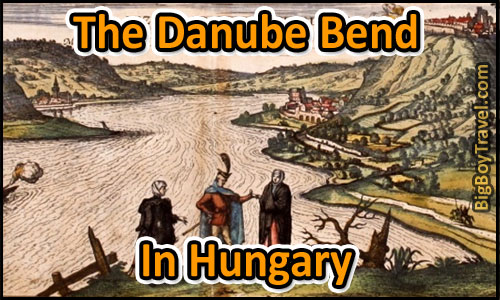
The Danube River Bend, Hungary:
Location: Danube River Bend (North of Budapest)
Time Required: 1 Full Day (mix and match below)
Getting Here: Details Route Info HERE
Fun Scale: 7.5 out of 10
The Danube is one of the World’s great rivers and flows through 4 modern European capitals (Vienna, Austria; Bratislava, Slovakia; Budapest, Hungary; Belgrade Serbia). One of the one interesting stretches of the Danube to visits is a place where the River makes quite a dramatic horseshoe curve known as the Danube Bend. Adding to the charm of the Bend are numerous smaller villages to help give you the old world effect. The sights in these cities vary dramatically from 300 year old mummies, to river bluff castles, to ruins of an ancient Roman city, and even a farm village where the houses still have thatched roofs. If you are in Budapest for a number of days, we highly recommend using one of your extra days to explore the Danube River Bend.
The Sights Along the Danube Bend:
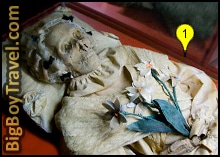
1. Vác, Hungary: Vác is a charming little town that was first a Roman settlement, and was completely destroyed in the Mongol invasion of Europe in 1242. After the Mongols left the city was rebuilt and today it offers a number of worthwhile sights including its collection of 18th Century mummies.
While renovating the Dominican Church (Fehérek Temploma) on Marcius Square in 1994, a large crypt was discovered with 265 mummies who were buried from 1731-1801 before it was bricked shut. The Crypt is all that remains of a former church called St. Micheal’s Church which was originally built in the 1300’s and fell into ruins in the 1800’s. The 265 mummies were found in excellent condition with each having a separate hand painted coffin and detailed elaborate clothing. The mummies and their clothes were found almost unchanged from the day they were buried because the perfect temperature and humidity conditions allowed them to mummify naturally.
Because the discovery has let anthropologists peek into lives of 1700’s Hungarian villagers it has been nothing short of an amazing find. Although the perfectly preserved mummies are unbelievable, we find the mummies’ painted coffins to be equally as amazing. Each of the mummies was actually found in their own unique, hand-painted coffins telling the life story of each one. The paintings on each coffin are very detailed and tell the life of each mummy. Each painting is different and celebrate the life of each person which includes flowers, and cross, plus many different quotes from the Bible. Many of the quotes can be difficult to read as some are in Hungarian, but many others are in both German and Latin. Artifacts and mummies from the St. Micheal’s Crypts can be seen today at nearby Memento Mori which also sits in Marcius Square in the Mansion looking building #15.
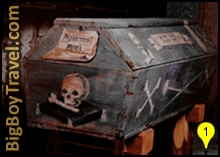
Moving around Vác’s main square, building #5 is the Bishop’s Palace which houses Roman and medieval artifacts. Sitting within a couple blocks to the East is the Piarist Church and Monastery which has a large and beautiful carved Holy Trinity Column sitting right outside its front doors. Further on is the massive Roman style Vác Cathedral with large pillars and frescoes on its ceiling and altar. Even further still to the East you can find the ruined wall which is all that remains of Vác Castle next to the Lakatosok Church.
On the opposite Western end of town near the Medieval Prison is a monument for the thousands of prisoners who were brutally killed there over the years and the Arch of Triumph was built in 1764 for a visit from Empress Maria Theresa. The Arch was built at the originally Northern entrance to the city and today one lane of street traffic goes right through it. If you do decide to walk over to the Arch we also suggest stopped by the Sharpened Tower which is the only remaining part of the former city fortifications and has been incorporated into a modern home.
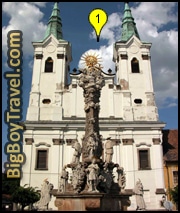
On large flat island across the river from Vác is the tourist favorite Bodor Manor (website) which is home to the traditional Puszta Horse Show. The whip yielding traditional Hungarian cowboys called Tschikos help give you a look into village life of days of old. Demonstrations including not only plow farming, herding of horses, and carriage rides, but also the famous the 5 horse race. In this show the daring Tschikos hook up 5 horse and races them around at high speeds while standing on top of the back 2 horses. The Bodor Horse Shows are open to non-resort guests on Mondays and Saturdays plus upon special requests for groups, but they have other activities available also. If you are lucky they will be having one of their the Knight and Stunt Horse Festivals while you are there. We suggest contacting them to see what activities they have over the dates you are in Vác.

Getting To Vác By Train: Take a local train directly to Vác from Budpest’s Nyugati Train Station in 44 minutes for 650 HUF. We suggest buying the ticket all the way to Štúrovo Train Station near Esztergom for 1,120 HUF which will save you a couple bucks and lets you hop off at Vác for no extra charge. The trip is 44 Minutes from Budapest Vac and another 36 minutes to Esztergom (Štúrovo). Getting To Vác By Bus: From the Újpest Bus & Metro Station you can take Bus #330. Visiting St. Michael’s Crypt: April-October Tuesday-Sunday 9am-5pm (Closed Mondays); November-March Closed; Cost 240 HUF; Location Marcius Square #15. Visiting Vác Cathedral: Open March-October Monday-Saturday 10am-Noon and 11:30-6pm, Sunday 7:30am-7:30pm; only open during service in the Winter. City Websites: (City | Tourism Department). http://muzeumvac.hu/programok_allando/1/MEMENTO-MORI.html
2. Esztergom, Hungary: Lying on the Slovak border, Esztergom started as the Roman settlement Solva Mansio before we even hit the year 100 A.D. making it first Roman village in the area. The city seems to be filled with firsts as it was not only the first capital of Hungary, but was also the birthplace of its first King, Saint Stephen (Szent István), and the home to Hungary’s first cathedral Saint Adalbert Church.

This village of firsts served as the capital of Hungary from 1000 to 1256 with the help of a large citadel known as Esztergom Castle which was built on top of the Castle Hill (Várhegy) to protect the city. By 1239 the city had grown quite a bit and a second little village was established at the foot of the castle called Watertown (Víziváros). There are some good sights in Watertown, like the Christian Museum (website) in the former Primate’s Royal Palace which has the largest ecclesiastical collection in Hungary. Included in their collection are artifacts and actually piece of Hungary’s first cathedral, Saint Adalbert Church, which was built in the 1100’s and no longer exists. It may be tempting to linger around Watertown, but try to focus almost all of your attention on Castle Hill.
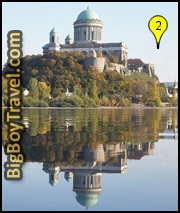
The sights on Castle Hill dominate the skyline of Esztergom no matter where you are in the city featuring the absolutely massive Basilica of Esztergom (website) sitting in the middle of the ruins of Esztergom Castle. Over the centuries Esztergom Castle was destroyed and rebuilt many times from fire, to Mongol invaders, to Ottoman occupation, and finally to World War II, but the base of the walls remain long the entire hill. The most visited parts of the Castle ruins are the walls and towers that litter the Southside of Castle Hill and houses the Magyar Museum (website). The Magyar Museum is pretty sweet as they take you through a bunch of the old castle rooms dating all the way back to the 1100’s including the throne room. With their story telling and a little imagination on how it must have been it is a very enjoyable experience.
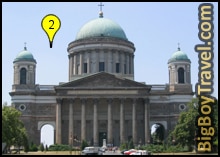
The main highlight of Esztergom which lies just a little further up hill overlooking the Danube River is the Basilica of Esztergom. The Basilica is not only the largest Church in Hungary, but also the 18th largest Catholic Church in the the World. Where the Basilica stands is the same place as not only the Roman camp and first church, but Saint Stephen (Szent István) was crowned the first King of Hungary. In order to build the church in 1820 they had take down the famous Bakócz Chapel which was all that remained of the original church that had be destroyed by Mongol invaders. Bakócz Chapel had been built in 1506 out of red marble by Italian master builders and because of its history they took it down piece by piece and actually reconstructed it inside the South end of the current Basilica. You really get the sense of history when you enter the Chapel and you could never tell they had to separate it into over 1,600 pieces before they could move it. Early during the building of the new Basilica, they built a Egyptian-style Crypt to bury archbishops which is creepy but you can still tour today. They also built a tunnel under the courtyard of the church known as The Dark Gate (Sötétkapu) because the lighting in the evening makes the open ends of the tunnel look like black holes.

Don’t leave Castle Hill without checking out the St. Stephen´s Coronation Statue on the Northern end of the former citadel. The large white statue is a pretty impressive mix of old and new depicting Stephen being crowned with modern elephant tusk-like curves protecting him. Stephen was a member of the Árpád dynasty who led the Magyar Tribes who first were the first Hungarians to settle the region in 896. Changing his name to Stephen from Vajk after converting to Christianity, his dad was the sitting ruler of the Magyar Tribes named Géza. Stephen grew his power by marrying the Duke of Bavaria’s daughter and after being crowned King, he made Christianity the official instead of Pagan ordering a church to be built in each city. Converting the country to Christianity was made easier as he gained their trust by promoting agriculture, protecting citizens’ property with strict laws, and set up a national military. Saint Stephen is still revered as a great leader today and Hungarians celebrate him with a feast each August 16th and church services honoring his relics each August 20th. St. Stephen’s Cathedral in Budapest even has the mummified right hand of the former king lead a parade.
The views of the Danube River from the Coronation Statue are awesome as you sit high up on a bluff, but the best views in the city are on St. Thomas Hill just Southeast of Castle Hill. St. Thomas Hill has great photo opportunities because you can get the Danube River, the Castle ruins, and the Basilica all in one beautiful frame.
Getting To Esztergom By Train: Take the same train you took to Vác another 36 minutes West toward that Slovakian town of Štúrovo. The Štúrovo Train Station is right across the Danube River about a 1 mile walk to the heart of Esztergom. Crossing the river is really easy and you take the large green, pedestrian friendly Mana Valeria Bridge (photo) which offers great views of the Cathedral. Alternatively you can reach Esztergom by local train from Budapest on the country train that takes 90 minutes and drops you off at the Southern train station a 30 minute walk from town, but this route doesn’t follow the Danube River or stop in Vac. Getting To Esztergom By Bus: Can be reached by Bus #880 which follows the river from the Újpest Bus Station or by Bus #800 from the Árpád Bus Station which goes through the country. Visiting The Basilica of Esztergom: April-October Daily 8am-6pm; November-March 8am-4pm. Entrance is Free; Treasury is 800 HUF; Crypt beneath the dome is 200 HUF; Climbing to the top of the dome is 600 HUF. Visiting The Magyar Museum: November-March Tuesday-Sunday 10am-4pm; April-October Tuesday-Sunday 10am-6pm; Closed Mondays year round. Cost is 500 HUF to walk around by yourself; Guided Tours are 1,800 HUF for adults; 900 HUF for students and seniors. http://www.esztergom.hu/
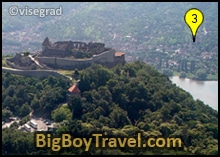
3. Visegrád, Hungary: Members of the Roman military were the first setters in Visegrád when they built a camp on the Northside of the Danube River on Sibrik Hill around 300 A.D. By 1009 A.D. the Hungarians had built a fortress on the hill which led to the area originally being called Visegrád meaning High Castle in Slovakian. The Sibrik Hill fortress was destroyed in the 1242 Mongol invasion of Europe and the further growth of the city moved on the Southside of the River.
The migration across the Danube was mainly because King Béla IV decided to build a new style of castle here which he believed would have better defenses. The new castle was built with an Upper Castle at the top of the highest peak and a Lower Castle which served as a buffer connecting the top part to the city below. The upper castle was unique as it was built in a triangle fashion which large towers which gave it better angles of defense than the traditional square castle. With its new castle complete, the city remained a quaint village until King Charles I of Hungary, who had been born here in Visegrád, moved the capital of Hungary here in 1325. Even after the capital was moved to Buda in 1405, Visegrád remained an important stop long the Danube and King Matthias Corvinus had his Summer Palace built here in the late 1400’s. King Matthias was very important in Hungarian history as he brought Hungary into it’s golden age. It was in Visegrád where King Matthias actually had famously arrested Vlad the Impaler (Dracula) before imprisoning him in is boyhood home of Corvin Castle.
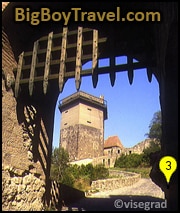
We like to start our tour at the King’s Palace grounds. The original palace built by King Matthias was put in ruins during Ottoman occupation in the 1500’s but a great re-creation has been built on the same spot. They have a lot of activities and you can even checkout the ruins of the former palace they have been excavating since 1934. As you follow the river North you will quickly run into the bright yellow Pálffy Palace. This beautiful Mediterranean-style mansion was built in 1860 has been for sale for a long time. The end of the river walk puts you at Solomon Tower which is the last remaining piece of the Lower Castle grounds. From Solomon Tower you can either take the old school route by hiking 30 minutes straight up the steep hill to the Upper Castle, take the longer winding road around to the Castle, or catch a tax near the river ferry dock.

Pretty close to the Upper Castle is the 750 meter long Downhill Luge Track (website) which has both luge and bobsled courses which the whole family will love. The luge is open daily from 10am-5pm and cast around 300 HUF per luge run.
Getting To Visegrád By Bus: The easiest way to get to Visegrád is to take the Bus 880 from Esztergom which takes 43 minutes and goes right to the heart of town. This same bus line also connects to Szentendre. Getting To Visegrád By Train: Visegrád is right between Vác and Esztergom on the local train route which may be tempting, but make it your last option. The Nagymaros Train Station is the closest, but is actually across the Danube River from Visegrád and there is no bridge connecting the two. Ferries run across the river run all day but because they only cross once an hour you could waste at least 60-90 minutes of your day waiting for the next one unless you are really lucky with the timing. To avoid any issues just stick with Bus 880. Visiting The Upper Castle Ruins: Is a 30 minute hike up the hill; entrance is 1,400 HUF. International Palace Games: really comes alive each year the second full weekend of July with the International Palace Games. Knights, jousting, and all sorts of live role playing brings a folk-like atmosphere to a real life Renaissance festival. City Website: (HERE). http://www.visitvisegrad.hu/
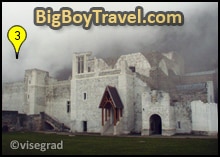
4. Szentendre, Hungary: Szentendre is an awesome village and the most visited Danube River town by tourists from Budapest. From roughly the 1300’s through the 1600’s the city grew mainly due to Serbians who were fleeing Turkish occupation in their own country. Many of the immigrants were artists and Szentendre grew with narrow alleyways and brightly colored houses. The city has remained largely untouched for the last few hundred years and along with it’s many museums it a great place to visit.
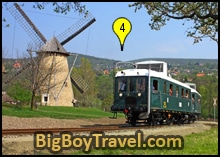
The main attraction in Szentendre is far and away the Skanzen Open Air Village Museum (Szabadtéri Néprajzi Múzeum). The Museum if filled with tons of cottage-like thatched roofed houses and even a large windmill. There always seems to be something cool going on in the village from re-enactments to period crafts people working in their shops. The Village is quite large and has a number of areas highlighting different regions of Hungary, but a handy tram circles the entire Village to help you get from point to point pretty quickly. The small farms of the village are a treat, as is the blacksmith shop, but if you are really lucky you’ll run into the guys dressed up a scary goats for the Busójárás Festival running the last the 6 days Farsang Carnival right before Lent each year. The Festival is essentially Hungarian Mardi Gras for old school villagers. Busójárás actually means Busó-walking which related to the Busós are the monsters the guys dressing up try to look like. As there last ditch effort to have fun and be naughty before Lent they wear wooly costumes, with goat horns, and demon masks.

After you’ve taken in Skanzen, head down the Szentendre’s compact old town. The city is even so old school that cars aren’t even allowed to drive in the small city center. You’ll love strolling along the city centers narrow passageways, especially if you are a photographer. The National Wine Museum is also a hidden gem of the city. Even a couple hours in Szentendre will give you a great feel for Medieval village life, folk traditions and architecture. The main folk attractions are typically closed on Mondays and the outdoor museum has limited availability in the Winter, so we suggest taking this trip on in the Summer Months.
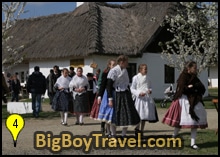
Getting To Szentendre By Bus: Getting to Szentendre is really easy as you just hop back on Bus 880 for another 40 minutes past Visegrád and you’re in the heart of town. Bus 880 will also stop at the Szentendre HEV Train Station before ending at Budapest’s Újpest Metro Station if you wish to continue.
Getting To Szentendre By Train: If you are looking at visiting directly from Budapest instead of from the Danube Bend, you just hop on the H5 HEV Train, which starts at Budapest’s Batthyány tér metro stop and goes directly to Szentendre after passing through Aquincum. To make it easy Szentendre happens to be the end of the HEV line to the North. The last HEV train back to Budapest leaves Szentendre at 11pm and only takes about 30 minutes to get back. Visiting Skanzen Museum: The HEV train station you’ll want to either hop on the local shuttle bus or get a taxi if you are going to the Open Air Museum to save yourself a 1 1/2 mile up hill walk. https://iranyszentendre.hu/en/
5. Aquincum, Hungary: The main draw to Aquincum are the ruins of a Roman City from the 2nd Century A.D. While not that large, the remains of the ancient city have been turned into a great open-air museum. There are excellent ruins of baths, a market, a roman forum, and even a complex heating system. We really love the Aquincum Museum (website) in the middle of the park which houses tons of Roman artifacts from the old city including pottery and some amazing art including the very detailed and brightly colored Hercules Mosaic.
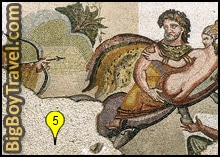
Within walking distance of the official Aquincum Ruins is on of 2 Roman Amphitheatrums from the days of the ancient city. The best preserved of these 2 is marked on our map a bit closer to Budapest and not only could hold 13,000 spectators, but also had a bigger footprint than the Colosseum in Rome. As you branch out from the Ruins consider checking out the towers of the old Gas Factory of Óbuda (Gázgyár Műemlék). While there isn’t much to do at the factory, photographers will love stopping by the old gas factory which look anything but industrial. The factory resembles a mini castle complete with tower’s resembling Harry Potter’s Hogwarts.
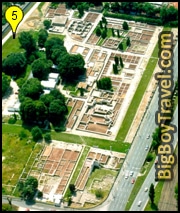
If you are cutting it too close on time to make it to Aquincum before the museum closes don’t feel like you have to rush. If it’s after park hours you can still see many of the ruins from the side of the road although you may not get to intimately walk among them. If you are really starting to get into the evening, remember that Aquincum is only 20 minutes from Budapest so you can always pop back up another day. We would rather have you spend more time in the charming village of Szentendre than overly rush to Aquincum.
Getting To Aquincum By Train: Getting to Aquincum is really easy as it is right in the middle of Szentendre and Budapest on the H5 HEV Train and is only 20 minutes to either. Buy your ticket all the way to Budapest and stop off at Aquincum for free on the way.
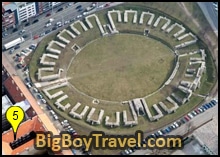
Getting To Aquincum By Bus: Alternatively you can get to the Aquincum Museum by taking either Bus 134 or 34 from Budapest’s Árpád Bus Station to the Záhony Street stop. Museum Hours: November-March Tuesday-Sunday 10am-4pm; April-October Tuesday-Sunday 10am-6pm; Closed Mondays. Park Hours: April 16th-October 9am-6pm; November-April 15th Closed. Cost: Museum and Park combo is 1,600 HUF; Park by itself is 1,000 HUF; Guided Tours are 6,000 HUF per group and must be booked in advance.
Best Time Visit The Danube Bend:
More stuff is open in the Summer for sure, but Mondays are the days you want to avoid and a lot of sights are closed.




